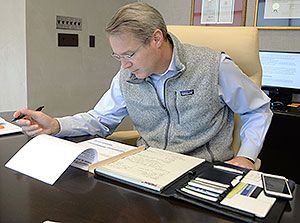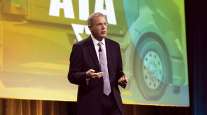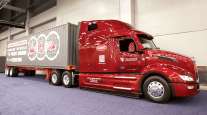ATA President Chris Spear Sees Progress in 2019 on Infrastructure, Workforce Development

American Trucking Associations President Chris Spear said he likes the direction trucking is going and credits tax cuts for breathing new life into the economy, sparking investment and giving President Donald Trump leverage to negotiate new trade deals.
“I couldn’t be more delighted with what this administration has done for our industry,” Spear said in an interview with Transport Topics. “[ATA Chief Economist] Bob Costello talks about the main drivers for trucking being manufacturing, construction and retail. Projections for all three are rock solid.”
With the economy on solid footing, Spear said he is optimistic about getting something done in 2019 on key policy objectives, including new funding for infrastructure and workforce development.
Spear on the Record
On the impact of tax reform on trucking:
“We conservatively estimate that $3.6 billion would go directly to our industry, of which 51% would be spent on employees, bonuses and pay, and ways to attract talent. The other 49% was largely allocated to new safer, more environmentally friendly equipment. We like both of those.”
On waiting to petition FMCSA on meal-and-rest-break rules until after ATA’s legislative fight on the issue had concluded:
“Once you launch a legislative strategy of this size and scope, it’s very hard to pull it back. You want to see it through. If we had submitted the petition while it was pending, it probably would not have been as well-received at the department because we had not exhausted our legislative options yet. I think the department would receive that petition much more openly knowing we had reached the end.”
On his goals for MCE:
“MCE is an opportunity to come together and really put some definition around what we are doing to help our industry grow long term. Solving F4A, solving workforce development, funding sound and safe infrastructure. These are all issues that people not only want to hear about, but they have high expectation that we are in a position to solve. And it’s tough.”
Finding and training new drivers and technicians is the “biggest headwind” currently facing the industry, according to Spear, who said ATA is addressing the issue on multiple fronts.
“A lot of administrative things can be done,” he noted. “Credentialing is an issue. States don’t recognize training done in another state. We have an average two months’ wait to get a commercial driver license.”
Spear said the industry is partnering with the military to help veterans transition to civilian truck driving jobs.
“You’ll see an urban hiring initiative,” Spear said, “to look at how we can attract more minorities and women.”
The initiative will use a combination of federal money, state agencies and local workforce boards to find and train people for jobs in trucking.
“We’re an industry that’s ready to embrace them,” Spear said.
Another key objective will be to get legislation passed in Congress to permit 18- to 21-year-olds to drive trucks in interstate commerce.
“The legislation we’re advocating is the DRIVE-Safe Act,” Spear said, noting that it would set minimum standards for training and require trucks with younger drivers to be equipped with cameras, collision-mitigation and speed governors of 65 mph or less.
The legislation has received bipartisan support, and Spear said the likelihood of it passing Congress right now is “very high.”
Another priority for ATA is to press the Federal Motor Carrier Safety Administration to determine that California’s meal-and-rest-break requirements are pre-empted under federal regulations. California law requires employers to provide a “duty-free” 30-minute meal break for employees who work more than five hours a day as well as a second duty-free 30-minute meal break for those who work more than 10 hours a day.
ATA petitioned FMCSA in late September in an effort to ensure uniform meal-and rest-break rules for truckers across the nation and Spear, who will update industry members Oct. 29 at ATA’s Management Conference & Exhibition, said he hopes to have the issue resolved by the end of 2018.
Prior to the petition, ATA conducted a four-year legislative crusade to include language establishing such uniformity in the FAA Reauthorization Act of 2018. The act, which reauthorizes the Federal Aviation Administration through 2023, was signed into law Oct. 5 and did not include the language.
ATA argues that California’s duplicative break rules hinder safety, create an unreasonable burden to interstate commerce and are incompatible with federal regulations.
Spear said ATA members are getting sued for not being able to comply with both sets of rules. Fees for pending and settled litigation have surpassed $500 million, money he said could be better spent on driver pay and more environmentally friendly equipment.

Finding and training new drivers is essential, Spear says. (Jaclyn O'Laughlin)
“Our companies in and around that region that operate in California are being sued for not being able to comply with duplicative meal-and-rest-break requirements,” Spear said. “We are interstate commerce. We have one set of standards. We’re not afraid of regulation. Just give us one clear set that we can abide by state-to-state.”
Spear also named finding a sound infrastructure funding mechanism as an upcoming goal. He said the success of Trump’s infrastructure plan, which includes $200 billion in federal funding to reach a total of $1.5 trillion for infrastructure investment, will hinge on how it’s paid for.
Raising the federal fuel tax, which has stagnated at 24.4 cents a gallon for diesel and 18.4 cents a gallon for gasoline since 1993, would be the best way to raise infrastructure revenue, Spear said. The federal fuel tax supports the Highway Trust Fund, which is expected to go bankrupt in 2020.
Spear pointed out that fuel tax hikes are administratively cheaper than “fake funding schemes” such as tolling or public-private partnerships, a staple of Trump’s plan.
“[The] fuel tax is the most conservative, immediate, impactful way to fund infrastructure right now,” Spear said. “[There is] not one proposal that will fund what the president wants other than the fuel tax. I would look for that issue to be front and center next year.”
ATA leaders also will keep automated driving technology on their radar in the coming year, according to Spear. Transportation Secretary Elaine Chao on Oct. 4 unveiled AV 3.0, the agency’s policy update of autonomous vehicle technology guidelines. FMCSA Administrator Ray Martinez is expected to include the subject among his talking points during an Oct. 29 session at MCE.
Spear said he likes the framework of AV 3.0 because it displays DOT’s willingness to learn from industry experts.
“Some very, very smart people invented some incredible solutions that can really benefit not only passenger but commercial vehicles,” Spear said. “That wasn’t born out of Capitol Hill or the Department of Transportation or some state agency. It’s being done by some really smart engineers that understand software, and 3.0 speaks to that.”





